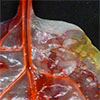| Nov 30, 2021 |
|
(Nanowerk News) Researchers from ITMO’s SCAMT Institute have developed a new nanomedicine testing system based on plant leaves. This new solution will make it possible to significantly cut down on animal testing.
|
|
The system was described in Nano Letters (“Bioinspired In Vitro Brain Vasculature Model for Nanomedicine Testing Based on Decellularized Spinach Leaves”).
|
|
One of the most challenging tasks for medical science nowadays is the development of an efficient model for testing of nanopharmaceutical treatments. This model has to represent the body part or system targeted by the treatment, such as the cardiovascular system, while also making it possible to monitor the treatment in action.
|
|
Existing models based on cell or tissue cultures cannot mimic the true complexity of a living organism. Some researchers also rely on microfluidic chips that can imitate the cardiovascular system with the channels that can be etched into them.
|
|
However, these chips are far from actual biological objects in terms of their composition and physical parameters. Moreover, they require a long and costly preparation and carry a risk of delivering imprecise research results.
|
|
“Despite the potential of nanopharmaceutics, as well as a great number of publications and preclinical trials, there still aren’t enough cases of these treatments seeing any practical application. These days, there is an extremely high demand for testing models that could imitate trials on live organisms. Any attempt at moving to a new model brings us closer to a breakthrough and helps spare the lives of a great number of lab animals,” explains Vladimir Vinogradov, a co-author of the article and professor at ITMO’s ChemBio cluster.
|
|
Taking into account the drawbacks of traditional models, scientists at ITMO’s SCAMT Institute developed a model based on a spinach leaf. At its core is the leaf’s vasculature with all cell components removed apart from the cell walls.
|
|
The model consists of cellulose, a substance that makes plant tissue more mechanically durable and stable in shape compared to that of animals. The resulting model is comparable to the arterioles and capillaries of the human brain in terms of their branching and diameter. This feature will make it possible to use the model to test both traditional and nanopharmaceutical treatments.
|
|
The new model has already been used to simulate thrombosis: first, the researchers inserted a model thrombus into the vasculature. Then, loaded nanoparticles were magnetically guided into the blocked area in order to dissolve the thrombus.
|
|
After successful tests of the model’s efficiency, the researchers are going to plant actual human cells into the cellulose scaffold to make the system an even more realistic imitation of the human vasculature.
|
|
“We want to attract the attention of the scientific community to the problem of irrational usage of laboratory animals. Currently, you only have to test a new substance on cell cultures before proceeding with animal trials. I think this is wrong – we need another stage in between these two which would identify flaws and provide room for improvement in drugs, thus saving the lives of many animals. Maybe plant-based models will serve as this middle stage,” says Aleksandra Predeina, a co-author of the article and a researcher at ITMO’s Faculty of Biotechnologies.
|
